No products in the cart.
January 14, 2025 1:03 pm
January 14, 2025 1:03 pm
Fenrir, a monstrous wolf, is one of the most important figures in Norse mythology. His character is both fascinating and frightening, representing the wild, untamed forces of nature that have fascinated people for centuries.
Fenrir’s story goes beyond just his existence; he is destined to play a significant role in Ragnarök, the catastrophic event that signifies the end of the world.
In this article, we will explore:
Get ready to dive into the captivating world of Norse mythology as we unravel the tale of Fenrir, a figure whose fate is intertwined with chaos and order.
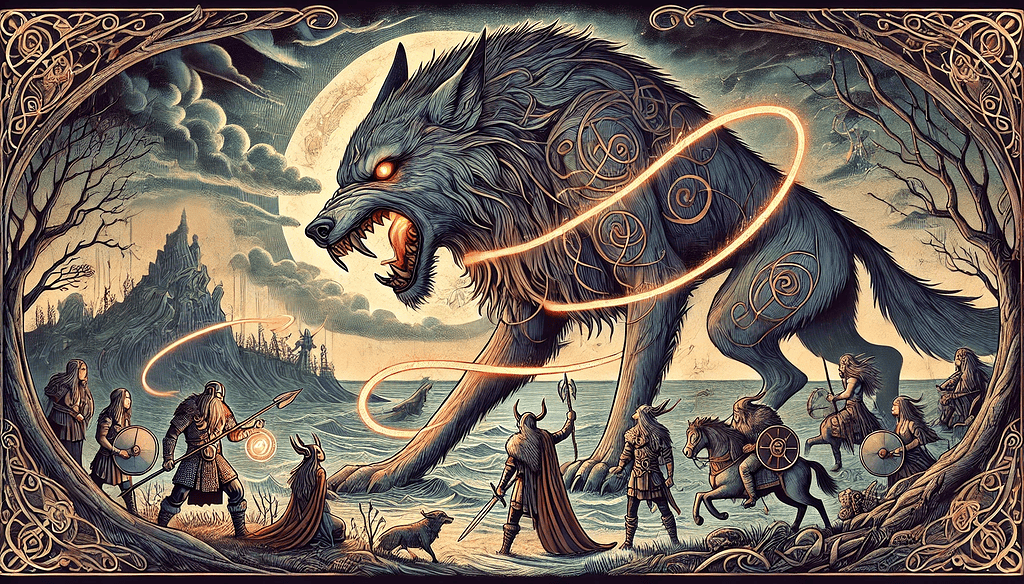
Fenrir’s origins are steeped in the complex relationships of Norse mythology. Born to Loki, the infamous trickster god, and the giantess Angerboda, Fenrir represents a powerful union of chaos and strength.
This lineage is significant, as it intertwines him with figures that embody both fear and fascination in the Norse cosmos.
Loki is known for his cunning nature and ability to navigate deceit with unparalleled skill. Often causing disruption among the gods, his actions have far-reaching consequences.
His unpredictable behavior raises questions about loyalty and order within the divine realm.
Fenrir is not alone in his formidable lineage. He shares his heritage with two equally significant siblings:
This triad of beings highlights a crucial theme in Norse mythology—destiny. Each sibling plays a pivotal role in the impending chaos of Ragnarök:
Fenrir’s existence, alongside his siblings, emphasizes themes of power, destiny, and the looming threat posed by their collective strength.
The intricate web of relationships establishes Fenrir as a central figure in understanding not only his own destiny but also that of all beings involved in Norse mythology.
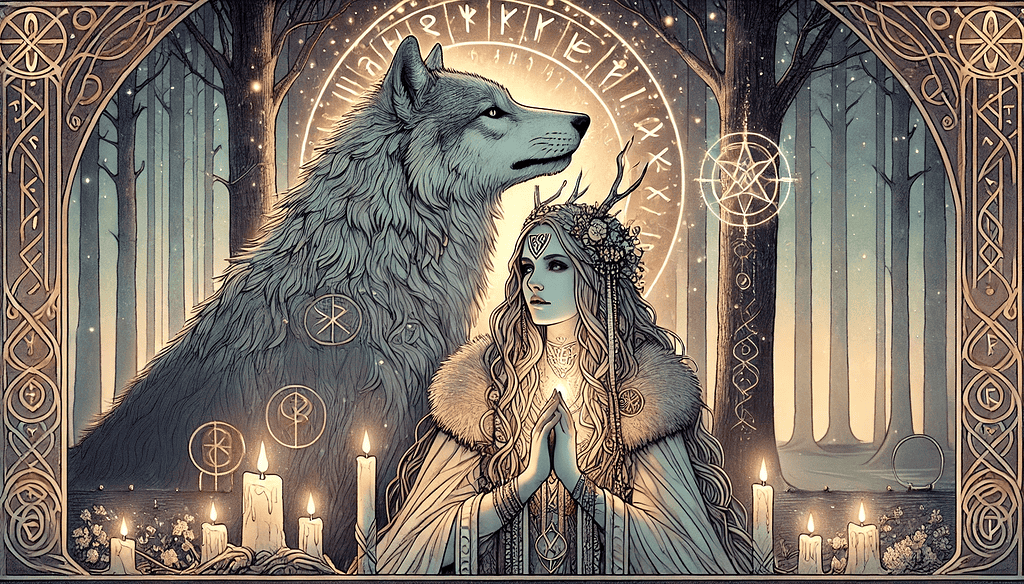
Fenrir, the monstrous wolf of Norse mythology, is not just any creature; he is a gigantic wolf whose immense strength and size set him apart from all beings.
Born from the cunning god Loki and the giantess Angerboda, Fenrir embodies raw power and ferocity. His stature alone can instill fear in the bravest of hearts.
Descriptions in various sagas depict him as a colossal creature capable of overpowering even the mightiest gods.
His jaws are said to be so wide that they could swallow the sun itself, making his mere presence a testament to his unparalleled ferocity.
Among both gods and mortals, Fenrir’s reputation is that of terror. Known for his insatiable hunger for destruction, he represents an ever-looming threat to the order maintained by the gods.
This fear resonates through the tales told by warriors around hearths, often invoking his name to describe impending doom.
Wolves carry profound symbolism in Norse culture:
In essence, Fenrir’s character encapsulates not only physical might but also deep symbolic meaning within Norse mythology.
His existence challenges the balance between order and chaos, setting a stage for future confrontations that will echo through time.
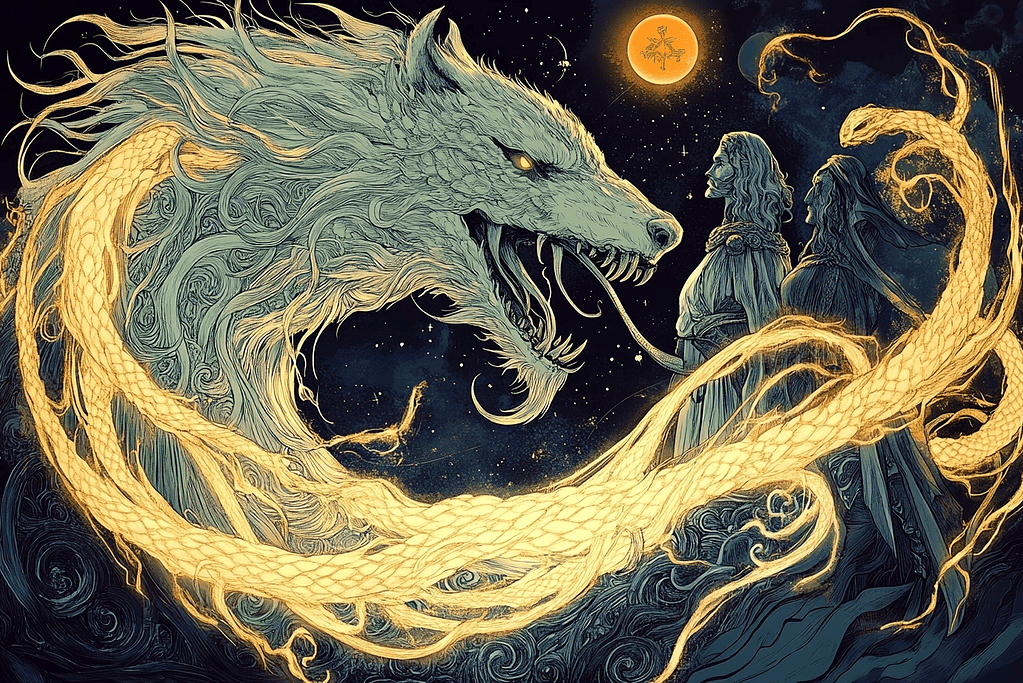
The fear that the Norse gods have towards Fenrir is deeply connected to prophecy and fate. Odin, the Allfather, along with his fellow gods, knew about the great danger this monstrous wolf represented. Here are the main reasons behind their fear:
Fenrir is predicted to play a crucial role during Ragnarök, the catastrophic event that signifies the end of the world in Norse mythology.
According to legend, he will break free from his restraints and cause destruction, ultimately leading to Odin’s death. Such a prophecy would instill terror in any deity who values their existence.
Being the child of Loki, the trickster god known for his cleverness and deceitful nature, Fenrir embodies chaos. Loki’s relationship with Fenrir’s mother, Angerboda—a giantess—further complicates matters.
This lineage makes Fenrir not just a beast but a representation of unpredictable destruction.
The idea of fate is very important in Norse mythology. The certainty of events like Ragnarök makes the gods feel helpless against their own destinies.
They understand that no matter how hard they try to bind or control Fenrir, his eventual rise is already predetermined.
Even other gods share in this fear. The story of Fenrir serves as a reminder that even divine beings cannot escape their fates. Each attempt to manage him only strengthens their worry about what lies ahead.
Fenrir’s legacy is one filled with fear and dread, intertwined with themes of destiny and chaos that run throughout Norse mythology.
As we explore his story further, understanding these fears enhances our understanding of his character and its significance for both gods and mortals alike.
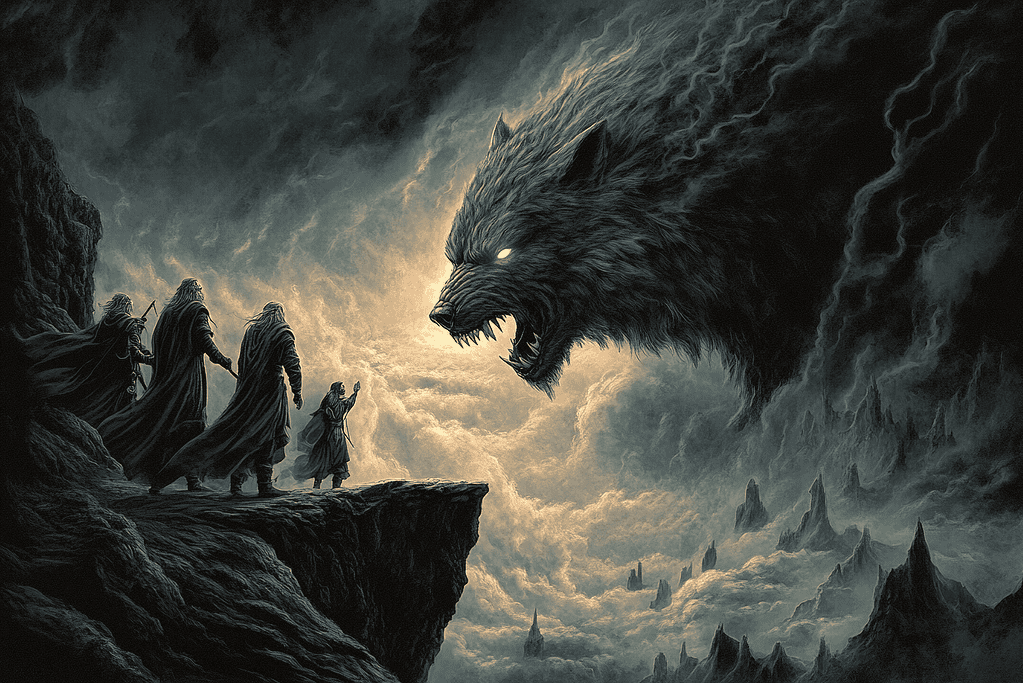
The binding of Fenrir is a crucial moment in Norse mythology, filled with themes of trust, sacrifice, and clever deception. As the gods realized the imminent danger posed by this great wolf, they came up with a plan to restrain him.
This plan heavily relied on the unique qualities of Gleipnir, a magical binding made by dwarfs using extraordinary materials.
Gleipnir wasn’t just any ordinary chain. It was something special:
These seemingly ordinary things combined to create an artifact that held immense power, capable of binding even the most formidable beasts.
The gods approached Fenrir with this chain under the pretense that it was a test of strength. Intrigued by their challenge, Fenrir saw an opportunity to demonstrate his might.
Among the gods, Tyr stood out because of his bravery and sense of honor. He understood the necessity of binding Fenrir for the greater good, even though he knew there were risks involved.
To make this plan work, Tyr made a significant personal sacrifice. He offered his hand as collateral to gain Fenrir’s trust.
This act was not taken lightly; placing his hand in Fenrir’s mouth symbolized goodwill and faith in their intentions.
The gods assured Fenrir that if they failed to hold him with Gleipnir, he would be free to go unhindered. In that moment, Tyr’s bravery shone through.
“Trust is forged in sacrifice,” he seemed to convey through his actions, fully aware that if they succeeded, he would lose his hand forever.
As Fenrir accepted this challenge and allowed Tyr’s hand into his mouth, the gods set about binding him with Gleipnir.
At first glance, it may have appeared as though they were simply engaging in a friendly contest, but deep down lay an intricate tapestry woven from deceit and necessity.
Once Gleipnir encircled Fenrir’s powerful form, he sensed something was wrong. Panic surged through him as he realized he had been deceived.
With all his strength, he struggled against the chain but found it unyielding. The clever trick had worked; he could not break free from its grasp.
In retaliation for this betrayal and feeling trapped by those he had trusted, Fenrir bit down hard on Tyr’s hand.
It was an act both tragic and symbolic—the loss represented not only Tyr’s physical sacrifice but also highlighted the broader conflict between chaos and order within Norse cosmology.
Fenrir’s howl echoed through the realms as he was ultimately bound against his will on Lyngvi Island, left gagged and imprisoned until Ragnarök when destiny would finally unfold.
Fenrir’s story encapsulates several key themes prevalent in Norse mythology:
Through these narratives surrounding the binding of Fenrir, we gain deeper insights into Norse beliefs about power dynamics among gods and creatures alike.
Each character plays their part diligently within this grand cosmic saga where chaos threatens order at every turn.
As we delve deeper into these stories, understanding Fenrir’s ultimate fate awaits us—his role during Ragnarök will reveal more about the cyclical nature of life and death within Norse mythos.
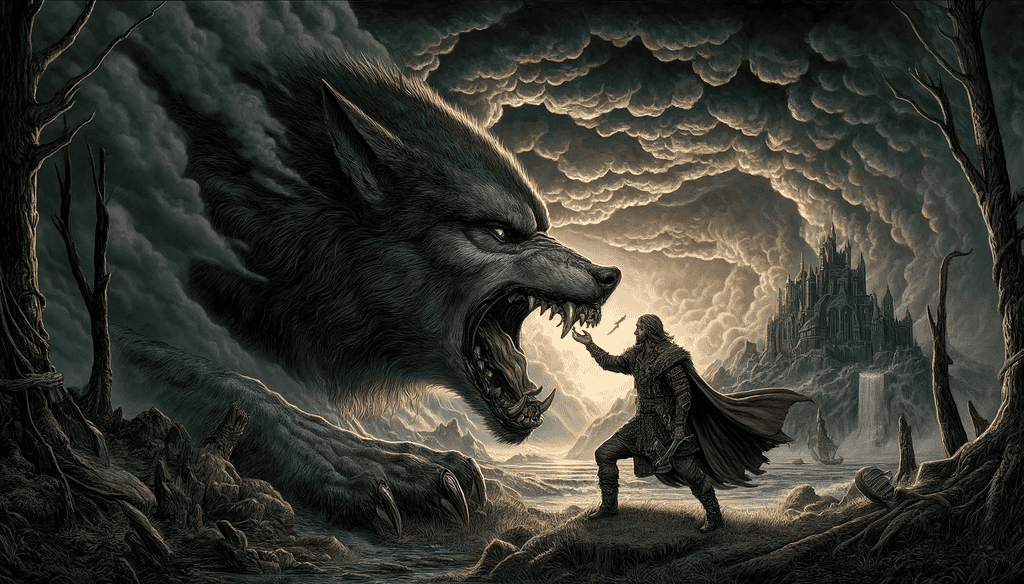
The binding of Fenrir had a significant impact on both the wolf and the gods. Once captured by Gleipnir, a magical ribbon made by dwarves, Fenrir found himself unable to speak and locked away on Lyngvi Island.
This remote location was chosen to ensure that the mighty wolf remained cut off from the destruction he could bring upon the world.
Unlike traditional chains, such as Laeding and Dromi, which Fenrir easily broke with his immense strength, Gleipnir had special qualities:
These elements symbolize the cleverness of the gods in their attempts to defeat Fenrir’s immense power.
Each material represents something intangible yet powerful, reflecting not only the wolf’s strength but also the cunning required to overpower him.
The aftermath of this binding was bittersweet for Tyr. In an act of bravery, he had placed his hand in Fenrir’s mouth as a gesture of trust, knowing he would lose it if they succeeded.
His sacrifice served as a poignant reminder that maintaining order requires difficult choices and personal losses.
While Fenrir lay imprisoned, the impending threat he posed loomed large over Norse mythology.
His eventual escape during Ragnarök would signal chaos and destruction, fulfilling the prophecy that foretold great calamities brought forth by Loki’s offspring.
The tale becomes more than just a story; it reflects on themes of sacrifice, power struggles, and destiny within the complex tapestry of Norse cosmology.
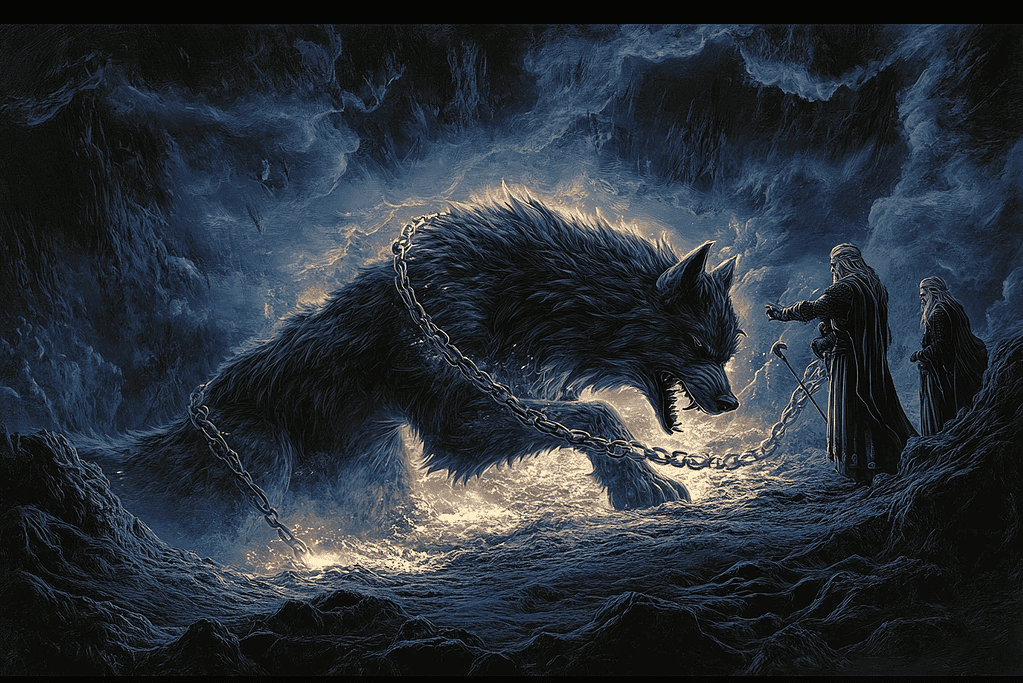
Ragnarök, the cataclysmic event that marks the twilight of the gods, is a cornerstone of Norse mythology. It signifies an era where chaos reigns, culminating in a fierce battle between gods and giants.
This apocalyptic clash brings forth several prophecies, including the pivotal role of Fenris, the great wolf.
As foretold, Fenris will break free from his bindings during this chaotic confrontation. The very chains that held him captive—crafted by dwarven artisans—will snap under the weight of destiny and destruction.
With a howl that echoes through the realms, he will surge into the fray, embodying vengeance and fury.
Key aspects of Fenris’s involvement in Ragnarök include:
The narrative surrounding Fenris serves as a stark reminder of the consequences intertwined with trust and betrayal.
His journey from a bound monster to a harbinger of doom illustrates how even those imprisoned by fate can rise to fulfill their destinies.
In this tale, we witness not only the tragic downfall of gods but also the relentless cycle of vengeance woven deeply into Norse cosmology.
Fenris stands as a testament to nature’s untamed power and its ability to disrupt even the most divine plans.
The legend of Fenris, known as the Fenris wolf, delves into profound themes that resonate deeply within Norse mythology and continue to be relevant today.
The immense power and uncontrollable nature of Fenris evoke fear among the gods. This fear drives them to take drastic actions, including binding him with Gleipnir.
In stories from the Poetic Edda and Prose Edda, this primal fear is depicted vividly, showcasing how it influences decision-making in both divine and mortal realms.
The gods’ dread of Fenris exemplifies how fear can lead to severe consequences. Their attempts to control what they cannot fully understand result in sacrifice and loss, particularly seen through Tyr’s courageous act of sacrificing his hand.
This act emphasizes that fear can compel individuals to make heart-wrenching choices in hopes of preserving order.
The narrative underscores sacrifice as a necessary path toward achieving control over chaos. Tyr’s willingness to place his hand in Fenris’s mouth reflects the lengths individuals may go to confront their fears.
This theme resonates with many, illustrating that confronting daunting challenges often requires significant personal cost.
The choice between personal sacrifice and the greater good is a recurring theme in mythology. Tyr’s loss serves as a poignant reminder that maintaining stability in turbulent times frequently demands difficult choices.
Fenris embodies the inevitability of destiny. The prophecies surrounding him indicate that no matter how much the gods attempt to bind him, his fate is sealed within the cycle of Ragnarök.
This theme raises questions about free will versus predestination, engaging readers in contemplating their own lives.
In contemporary terms, the story encourages individuals facing trials beyond their control to consider their responses.
Do you succumb to despair or choose to confront these obstacles? Fenris’s legend suggests that bold steps taken amidst uncertainty can lead to transformative outcomes.
The themes explored through the legend of Fenris resonate today, as individuals grapple with their fears and uncertainties.
Just as the gods confronted an uncontrollable force, you might find yourself facing circumstances that feel overwhelming.
These themes not only highlight the timelessness of Norse mythology but also encourage reflection on your own journey through life’s unpredictable landscape.
As we delve deeper into Fenrir’s tale, consider how these motifs shape your understanding of both ancient narratives and modern experiences.
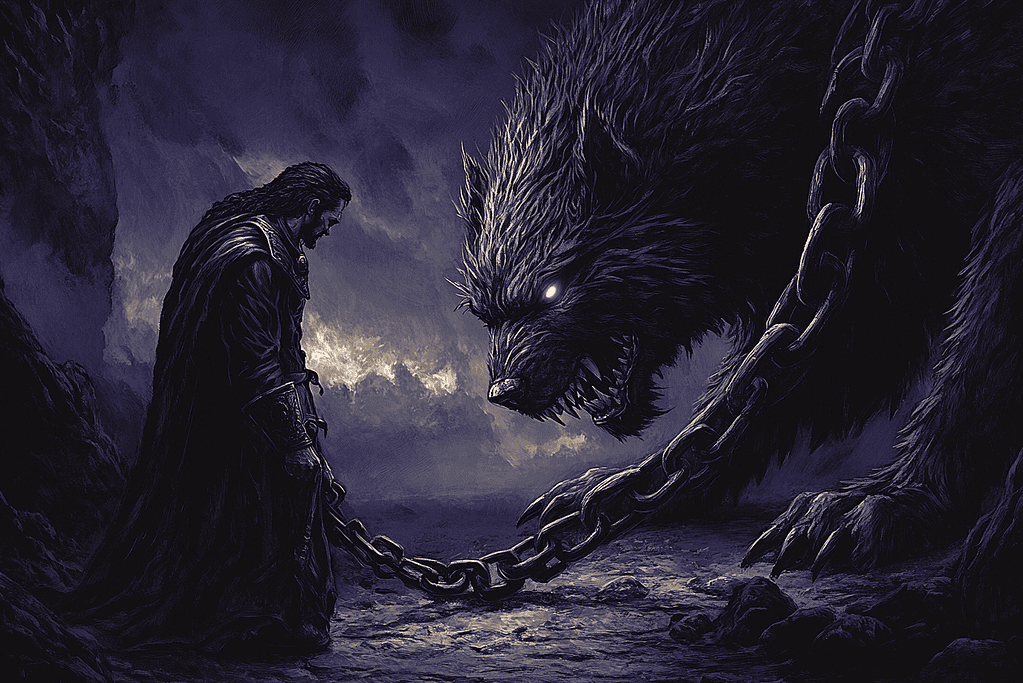
Fenris Wolf is a legendary figure in Norse mythology who represents a complex duality. He embodies both chaos and destruction, but also transformation and rebirth. To fully understand Fenrir’s story, we must grasp this dual nature.
Fenrir’s ferocity serves as a stark reminder of the dangers posed by unbridled passions and instincts. In stories, his unchecked power leads to catastrophic events, illustrating how chaos can spiral out of control when not managed.
Beneath this rawness lies potential beauty. When channeled wisely, primal forces can lead to profound transformations, symbolizing growth and renewal. This highlights the importance of embracing our darker sides while maintaining awareness of their consequences.
Understanding Fenrir in Norse mythology for complete beginners involves recognizing this balance between light and dark.
We can learn to navigate our own complexities, acknowledging that within each of us lies the capacity for destruction and rebirth. By embracing this duality, we find strength in vulnerability, ultimately leading to personal growth and resilience.
Fenrir is a significant figure in Norse mythology, known as a monstrous wolf. He is the child of Loki and the giantess Angerboda, and plays a crucial role during Ragnarök, the cataclysmic event marking the end times.
Fenrir’s origins trace back to his parentage: he is the offspring of Loki, the trickster god known for his cunning nature, and Angerboda, a giantess.
His siblings include Jörmungandr (the Midgard Serpent) and Hel (the goddess of the underworld), which adds to his significance in Norse cosmology.
The gods, particularly Odin and his allies, dread Fenrir due to prophecies predicting his destructive actions during Ragnarök. His immense strength and potential for chaos instill a deep-seated fear among them.
Fenrir was bound by a magical ribbon called Gleipnir, crafted by dwarves.
The gods tricked him into allowing himself to be bound through a clever ruse involving Tyr, who sacrificed his hand as a gesture of trust while knowing it would be bitten off when they succeeded in binding him.
During Ragnarök, Fenrir is foretold to break free from his bindings and will devour Odin. However, Odin’s son Vidar will avenge his father by slaying Fenrir shortly after.
The legend of Fenrir explores themes such as sacrifice, fear, inevitability, and duality.
It highlights how fear drives actions against uncontrollable forces and reflects on the balance between chaos and transformation within ourselves.
Further reading:
Lindow, J. (2002). Norse mythology : a guide to the Gods, heroes, rituals, and beliefs (First edition.). Oxford University Press. https://doi.org/10.1093/oso/9780195153828.001.0001
Thomas A. DuBois (1999). Nordic Religions in the Viking Age. The Middle Ages. Philadelphia: University of Pennsylvania Press.
Simek, Rudolf. (2003). Religion und Mythologie der Germanen. Wiss. Buchges.
Simek, Rudolf. (1993). Dictionary of northern mythology. D.S. Brewer.